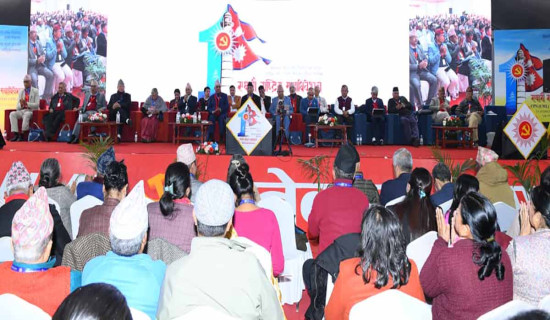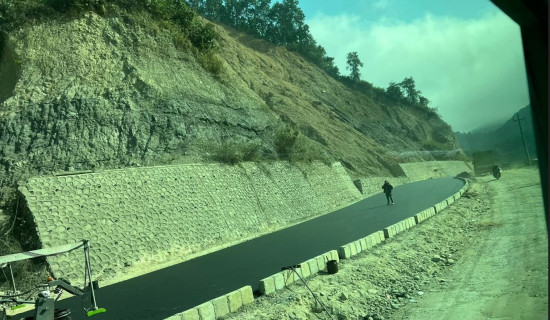- Monday, 15 December 2025
Pursue FDI Pledges For Optimum Results
Industrial development is indispensable for economic and social progress. It is a precondition for raising levels of income and employment in developing countries including Nepal. Realising this, Nepal government had initiated the planned development of the industries since launching of the First Plan in 1956. But even after completing fifteen periodic plans, Nepal is still one of the least industrialised countries. One of the main factors contributing to sluggish growth of the industrial sector is the extreme shortage of managerial and entrepreneurial talent in the country.
Private sector industries in many sectors have emerged after the liberalisation of the economy. However, the sector, the so-called main engine of growth and the main provider of economic activity for poor people, is still dormant due to lack of sufficient capital as well as risk-taking ability. The private sector investment is still directed to the quick-yielding business activities. To fill this vacuum, the government has been effortful to attract foreign investment in the country.
The increasing competition for attracting foreign direct investment (FDI) among developing countries is clear evidence of its invaluable significance in industrialisation. The FDI brings not only large and cheap capital, but it also facilitates the transfer of modern technology, entrepreneurial abilities, technological and managerial skills, sound business culture, and bring access to international markets. The FDI is seen as a way of filling in gap between domestically available savings and desired level of savings necessary to achieve higher economic growth. Evidence shows that they have also positive spillover effects on domestic firms and can stimulate domestic investment.
Economic reform
With the restoration of multiparty democracy in 1990, the government has been pursuing a series of economic reform measures designed to create an atmosphere conducive to private sector involvement in the industrialisation. It declared Industrial Policy 1992 (amended 1997) and Foreign Investment and One-window Policy 1992 (amended 1997). Besides, trade and financial liberalisation policies were also followed. The government organised ‘Nepal Investment Forum’ in 1992 in which the investors from different countries had shown interest in 115 project proposals presented by the government. It is also striving to attract NRN investment by providing various incentives.
Every year the government shows the increasing trend of FDI inflow in the country. However, the FDI seems to be limited in paper. No one knows how many of them have come into operation, how much they have been contributing to GDP, public revenue, employment generation, export promotion or import substitution and foreign exchange earnings. It seems that most of them have merely been registered and have rarely come to existence. The FDI is concentrated in the countries having well-developed infrastructure, large domestic markets, and rich in natural resources. Judged from this viewpoint, Nepal is said to have huge potential for FDI due to its rich natural resources and being one of the low-cost locations among South-Asian countries.
Nepal undoubtedly possesses a very small size of the national market. However, this is not a hurdle since it is near vast markets of China and India. The industrial countries have been generous in providing various tax concessions to ensure the products of the least developed countries like Nepal get access to industrial countries. ‘Everything but arm initiative’ of European Union, which eliminates all barriers on imports from very poorest countries, removes the market constraint. However, foreign investments are not coming as expected or have not come into operation even after registration. While neighbouring countries India and china attracted huge level of FDI in past few years, Nepal could not. Foreign investors did not choose Nepal as their investment destination due to instability and uncertainty looming the country.
What are the obstacles in the way of foreign investment? Broadly speaking, it is mainly due to lack of sound business environment in the country. Investment climate depends on three broad factors: macroeconomic stability and openness, which includes sound and sensible macroeconomic and trade policies; good governance and strong institutions, which includes limits on bureaucratic harassment, the rule of law, and the control of corruption and crime, effectiveness of the government in providing sound regulatory structures for promoting a competitive private sector, effective provision of public services, and the quality of infrastructure, including power, water, transport, and telecommunications.
Inadequate infrastructure
The problems that are hurting the domestic industries – such as inadequate infrastructure, scarcity of raw material, scarce skilled manpower, lack of good governance, rampant corruption, and insecurity, among others – also discourage FDI. The growth of the private sector is vital to achieving higher rate of economic growth and to the reduction of poverty. Despite decades of planned development efforts, the economic growth of Nepal is lowest even in the SAARC region. Hence, the situation necessitates the creation and the promotion of the strong private sector by creating enabling business environment. The third investment summit that took place on April 28-29 sought to promote Nepal as a lucrative investment destination. About 1,700 people from 55 countries were reported to have participated in the summit.
The Investment Board Nepal (IBN) prepared a list of 151 projects for foreign investment and showcased at the summit. These projects were expected to contribute to the overall development of the country by promoting foreign investment. There are reports of several commitments as well. The government must be effortful to translate the commitments into reality. There is a powerful evidence that the investment climate is a crucial ingredient for growth and for poverty reduction. The countries, which improved their investment climates, are doing well in attracting FDI, whereas some countries could not due to their poor investment climate. Future inflow of FDI to Nepal will depend largely on the sound investment climate.
(The author is the Professor of Business Economics.)
















